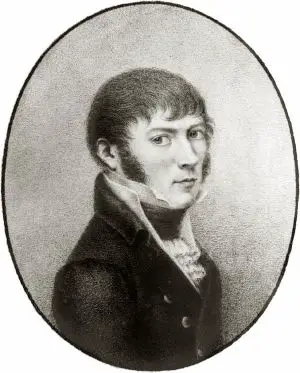Joseph von Fraunhofer
Joseph von Fraunhofer (March 6, 1787 – June 7, 1826) was a German optician. When Fraunhofer became an orphan at the age of 11, he started working as an apprentice to a harsh glassmaker named Philipp Anton Weichelsberger.
Biography
In 1801 the workshop in which he was working collapsed and he was buried in the rubble. The rescue operation was led by Maximilian IV Joseph, Prince Elector of Bavaria (the future Maximilian I Joseph). The prince entered Fraunhofer's life, providing him with books and forcing his employer to allow the young Joseph Fraunhofer time to study.
After eight months of study, Fraunhofer went to work at the Optical Institute at Benediktbeuern, a secularised Benedictine monastery devoted to glass-making. There he discovered how to make the world's finest optical glass and invented incredibly precise methods for measuring dispersion. In 1818 he became the director of the Optical Institute. Due to the fine optical instruments he had developed, Bavaria overtook England as the centre of the optics industry. Even the likes of Michael Faraday were unable to produce glass that could rival Fraunhofer's.
His illustrious career eventually earned him an honorary doctorate from the University of Erlangen in 1822. In 1824, he was awarded the order of merit, became a noble, and made an honorary citizen of Munich. Like many glassmakers of his era who were poisoned by heavy metal vapours, Fraunhofer died young, in 1826 at the age of 39. His most valuable glassmaking recipes are thought to have gone to the grave with him.
Scientific research
In 1814, Fraunhofer invented the spectroscope, and discovered 574 dark lines appearing in the solar spectrum. These were later shown to be atomic absorption lines, as explained by Kirchhoff and Bunsen in 1859. These lines are still sometimes called Fraunhofer lines in his honour.
He also invented the diffraction grating and in doing so transformed spectroscopy from a qualitative art to a quantitative science by demonstrating how one could measure the wavelength of light accurately. He found out that the spectra of Sirius and other first-magnitude stars differed from each other and from the sun, thus founding stellar spectroscopy.
Ultimately, however, his primary passion was still practical optics, once noting that "In all my experiments I could, owing to lack of time, pay attention to only those matter which appeared to have a bearing upon practical optics."
See also
- Fraunhofer society
- Fraunhofer diffraction
- Fraunhofer line
ReferencesISBN links support NWE through referral fees
- Aller, Lawrence H. (1991). Atoms, Stars and Nebulae, 3rd ed.. Cambridge University Press. ISBN 0-521-32512-9.
External links
bn:ইয়োসেফ ফন ফ্রাউনহোফার bs:Joseph von Fraunhofer cs:Joseph von Fraunhofer da:Joseph von Fraunhofer de:Joseph von Fraunhofer el:Γιόζεφ φον Φραουνχόφερ es:Joseph von Fraunhofer fr:Joseph von Fraunhofer hr:Joseph von Fraunhofer id:Joseph von Fraunhofer it:Joseph von Fraunhofer he:יוזף פראונהופר nl:Joseph von Fraunhofer ja:ヨゼフ・フォン・フラウンホーファー pl:Joseph von Fraunhofer ru:Фраунгофер, Йозеф sq:Joseph von Fraunhofer sk:Joseph von Fraunhofer sv:Joseph von Fraunhofer
